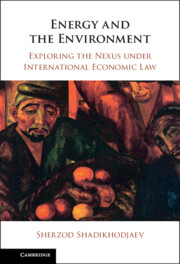Book contents
- Energy and the Environment
- Energy and the Environment
- Copyright page
- Dedication
- Contents
- Figures
- Tables
- Table of Cases
- Table of Treaties
- Table of Other Legal Texts (and Drafts)
- Abbreviations
- Introduction
- 1 Foundations of the Energy–Environment Nexus and International Economic Law
- 2 Energy Trade Control and Environmental Protection
- 3 Energy Subsidies and the Environment
- 4 Pro-environmental Energy Standards and Trade
- 5 Energy Investment Regulation and the Environment
- 6 Energy and Green Technologies
- Conclusion
- Book part
- Bibliography
- Index
3 - Energy Subsidies and the Environment
Published online by Cambridge University Press: 30 April 2024
- Energy and the Environment
- Energy and the Environment
- Copyright page
- Dedication
- Contents
- Figures
- Tables
- Table of Cases
- Table of Treaties
- Table of Other Legal Texts (and Drafts)
- Abbreviations
- Introduction
- 1 Foundations of the Energy–Environment Nexus and International Economic Law
- 2 Energy Trade Control and Environmental Protection
- 3 Energy Subsidies and the Environment
- 4 Pro-environmental Energy Standards and Trade
- 5 Energy Investment Regulation and the Environment
- 6 Energy and Green Technologies
- Conclusion
- Book part
- Bibliography
- Index
Summary
Like import and export restrictions discussed in Chapter 2, energy subsidies also have environmental implications. The IEA defines ‘energy subsidy’ as ‘any government action that concerns primarily the energy sector that lowers the cost of energy production, raises the price received by energy producers or lowers the price paid by energy consumers’. Such subsidies are granted to promote energy security, employment and economic growth, innovation as well as social and/or environmental goals. Energy subsidies are subject to WTO disciplines. Removing fossil fuel subsidies will help reduce fossil CO2 emissions to the levels necessary to contain global warming and improve public health by cutting pre-mature global air pollution deaths by more than half. By contrast, providing subsidies for renewable energy can advance a climate-friendly policy of diversifying and decarbonizing national energy systems. Thus, the energy–environment nexus here centres on the issues of eliminating harmful fossil fuel subsidies, on the one hand, and exploring policy flexibilities for renewable energy subsidies, on the other.
Keywords
- Type
- Chapter
- Information
- Energy and the EnvironmentExploring the Nexus under International Economic Law, pp. 99 - 141Publisher: Cambridge University PressPrint publication year: 2024

